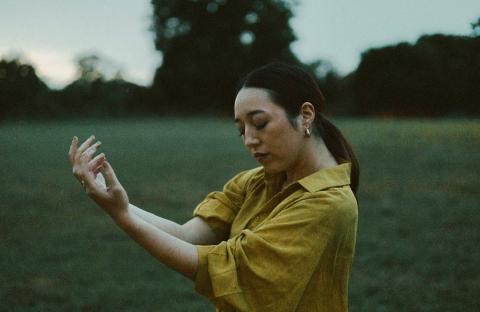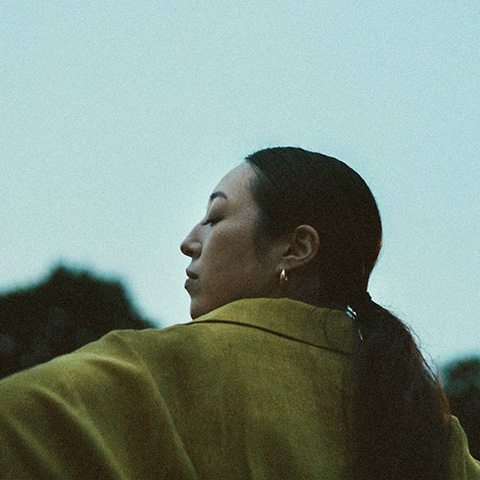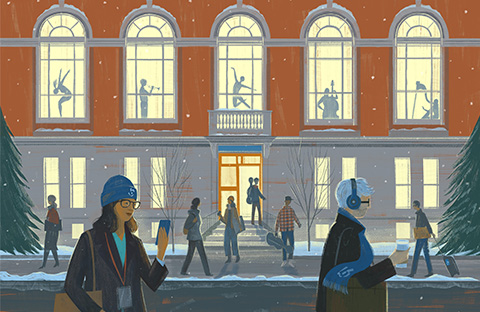Somatic Intelligence

Photo by Aly Hansen
“I have always loved dance and never knew why. I need to know why I like it. I’ve come to realize that it’s a method of processing for me,” says Boston Conservatory at Berklee contemporary dance alum Kate Gow (B.F.A. '19). Through Gow’s lifelong investigation into the why of her relationship with dance, she has developed a “somatic intelligence” as the foundation of a unique career that bridges dance performance, technology, and digital archiving. Although these varied interests seem decidedly disparate, she brings them together in a new podcast called Dances with Robots, for which she serves as archivist and web designer. The podcast, which examines the intersection of dance and technology, is cohosted and executive produced by fellow Conservatory alum Ariane Michaud (B.F.A. '16, contemporary dance). Here, Gow connects the dots of her emerging multihyphenate career.
What drew you to the intersection of dance, technology, and archival work?
It has taken me a while to unspool the connecting thread from these seemingly unrelated interests, but I figured out that what I love is the process of keeping something; I’ve been obsessed with the idea of an archive since before I had the words for it. At the Conservatory, I was introduced to the idea of the archive of the body—a physical repository for the kinesthetic and cognitive experiences that made up the person I thought of as “me.” The advent of accessible technology has the possibility of shifting the way we think about what an archive is and how it functions in our daily life: Is an old Tumblr blog an archive? I think it is. We are sharing the archive of our bodies every day using technology.
How does your work across each of these areas inform your work in the others?
I couldn’t have one without the others. I struggled when making the choice to pursue a Conservatory education because I craved a sort of traditional academic rigor, but I realized quickly that so many of the smartest people that I knew had a kinesthetic intelligence that informed their work. Dance and my archival work are so intertwined, as they are both the way that I organize my inner world.
"I can say that dance is the language I give to myself to understand myself. When I learned to code, it was a similar feeling—it is all a sort of languaging process. Choreography is computation."
—Kate Gow

Were you able to explore your interest in emerging technologies during your time at Boston Conservatory?
Arriving at the Conservatory, I had a narrow view of what a dance education could prepare me for in the future. Through faculty members Sydney Skybetter, Joy Davis, and Carlee Travis, I understood that the so-called “dancerly intelligence” was applicable, and maybe even vital, in other spheres. By taking classes in critical theory and dramaturgy, creating my own emphasis in dance and technology, and doing independent studies that allowed me to deepen my research into the tie between artistry and its relationship with emerging technology, I became able to find the words to communicate why I always thought dance was so important. I had spent my entire life up until that point understanding how movement in space creates meaning, and when we live in a world where surveillance cameras are pointed at bodies and attempting to parse meaning from them, a dancerly intelligence becomes essential to reduce harm to those bodies.
How did the Dances with Robots podcast come to be? What’s it about?
While I was a student at Boston Conservatory, I volunteered for the first Conference for Research on Choreographic Interfaces (CRCI) in 2016 with Ariane, and we both have been working on the CRCI team ever since. We produced an annual conference at Brown University, but during the pandemic we shifted to finding a way to expand upon the conversations and community that we fostered through our conferences and created the Dances with Robots (DWR) podcast. The best part of CRCI is our community, so DWR serves as a way we explore how the artists, activists, and technologists in our community thrive through collaboration and interdisciplinary practice. I stepped into the role of digital archivist and web designer for DWR and also cohosted a vaguely historical but mostly conversational episode with Sydney Skybetter. My favorite part of the process has been going back through the ephemera of past conferences and seeing how the threads of conversations we started in 2016 are still going and how CRCI has cultivated prolific, long-standing partnerships between artists and technologists.
How are AI and emerging technologies impacting dance today, and how might they play out in the future? What excites and concerns you most?
There has been a historical trend where new technology has been introduced through the lens of entertainment in order to make it less threatening to the layperson, so really, emerging technologies have always impacted dance. Right now, I am thinking a lot about the proliferation of surveillant technologies: how the everyday person is forced to—knowingly or unknowingly—perform for a camera whenever they step foot in the public sphere and its relationship to things like hours-long TikTok livestreams and general internet voyeurism. You’ll never be able to totally divorce the idea of incorporating technology into artistic practice, but I’ve seen it done so well and I’ve seen it done so poorly. New avenues of connection, inspiration, and reflection will always excite me, but I exercise deep caution when harm to bodies is seen as a necessary evil in pursuit of new technology. Foundationally, I think artists have the power to create productive interventions in these spaces and create a more just technological landscape.
Learn more about the Dances with Robots podcast. “Somatic Intelligence” first appeared in the 2024 issue of STAGES, Boston Conservatory’s annual magazine. READ: STAGES 2024

